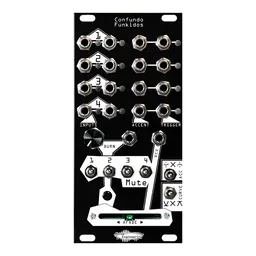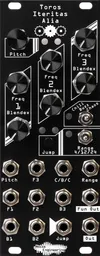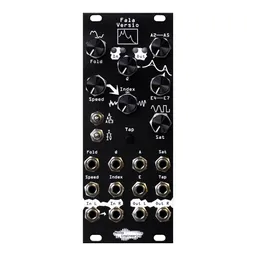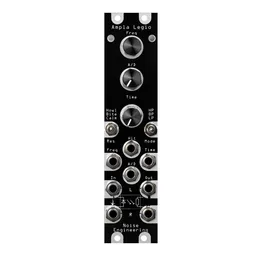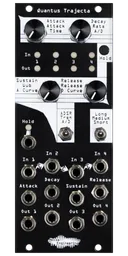We recently released two new utility modules, Jam Jam and Quantus Trajecta. Last week we took a deep dive into Jam Jam, and this week we’ll be exploring Quantus Trajecta. QT was designed first and foremost as a polyphonic envelope generator, but its unique feature set and immediate interface make it a great choice for a variety of different patching needs.
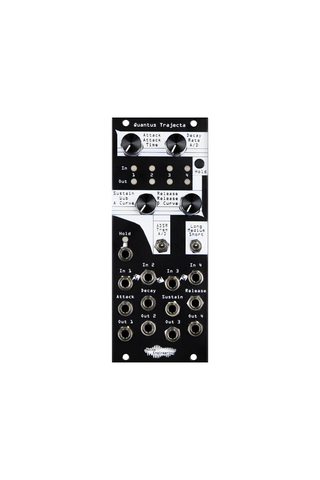
What is polyphony?
Most Eurorack voice patches are monophonic: only one note can be played at a time. Polyphonic synthesizers, however, can play multiple notes at the same time; this means you can produce chords and overlapping notes, which can be useful for certain styles of playing. Polyphony in Eurorack can get complicated, simply because most modules are designed for monophonic patching. Quantus Trajecta makes the dynamics control of multiple voices easy, since the parameters are shared between all four envelope generators.
Pick your poison: ADSR, A/D, or tremolo
We designed the Quantus Trajecta with a few different envelope styles. There’s a traditional ADSR, which is curved exponentially to sound extra nice when controlling VCAs.
Of course, we didn’t stop there. First, there’s a unique attack/decay envelope, which takes inspiration from our Percido voices and has adjustable envelope curving per stage. Lastly, we have the Trem shape, which is an ASR envelope with a built-in LFO, perfect for creating warbly tremolo-y tones that evolve over time.
We spent a lot of time fine-tuning each of these envelope types to fit into as many different patch styles as possible. Here's an example of an ambient melodic patch using Trem:
Envelope generation for performance patches
While being a perfect choice for more traditional polyphonic patches, Quantus Trajecta is also a wonderful performance tool. I often use QT to control four unrelated voices in techno patches. This makes it easy to, for instance, control the decay time of all four voices at once with a single control, which is a great way to build tension with one control.
The Hold control is another fun way to manipulate a patch on the fly: while the button is pressed all four envelopes freeze at their current level, then continue from that level when it’s released. Hold also has a gate input, so you can easily use clock dividers or gate sequencers to add accents and variation to a sequence.
The backstory
Several years ago, we had a meeting with a composer and left inspired to create a whole line of polyphonic modules. You’ve seen many of these already: Quantus Pax, Quantus Ampla, and Quant Gemi were all designed with polyphonic patching in mind (why yes, this does mean we have more ideas in the works). The initial concept for a polyphonic envelope generator was based purely around the envelope structure we used on the Percido modules. The original had only three potentiometers and was 8 HP, but from the start we had four gate and CV ins, four envelopes out.
It was laid out so badly that none of us could get our fingers around the knobs because they were too close together. We got firmware working on it (we think, it was REALLY hard to test). Other projects took priority and it languished, but over the years, we had several people ask about a stand-alone Percido module (looking at you, Koyl, Benki….and more).
Over time, we phased out the CPU that was on the original prototype. At some point, we came back to it, and moved it to a new one that we were way more excited about. We ordered a new proto, but this one also still only had three pots and 8HP.
It wasn’t until we said, no. It needs four pots and 10HP to be what it needs to be. Once we had the hardware in hand, we quickly realized we could use a similar control structure for a few different envelope types.
ADSR was an obvious choice, but it took a surprising amount of tweaking to get the curves to sound how we wanted them to, and the timing and level controls were scaled to be easily performable. The tremolo shape was the last addition to QT, and it evolved as a variation on the more traditional ASR. It’s a very pretty envelope shape that’s evocative of rotary speakers and electric pianos, and it adds a lot of flair to any voice.
Once we decided on the core envelope shapes we tried out a number of extra global parameters (you can find more info on the various incarnations of QT in the user manual) but finally decided that a universal rate switch and the unique Hold control would round things out nicely. From there it was just tweaking.
The new MCU was perfect for it, but it was the same one that is on the Jam Jam. If you read the origin story of that one, you’ll know that we hit a dry spell during the great parts shortage of 202x. So we were able to prototype but not go to production. We sat on QT.
An unexpected benefit here was that in the midst of this, we were working on a completely unrelated product and needed a part we didn’t have. We have collectively spent ridiculous amounts of time on searching for parts that we can use that are low-cost and fit our needs, but this time, the gods smiled on us and Kris looked at Stephen and said, “Sooooo about this part. I think it just might work.” It seemed too good to be true. And if we could use it, it would bring the cost of the module down a LOT. So the delay was, in this case, not a terrible thing. We redesigned it once more, this time on the new part. This also let us validate the cheaper part for future products, so you get a cheaper QT, we get the knowledge of a new part!
Buy yours today
Quantus Trajecta is available and shipping now (in fact, some of you have already started patching with them!). Order yours today from our webshop or your favorite local retailer!
